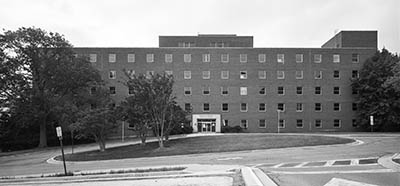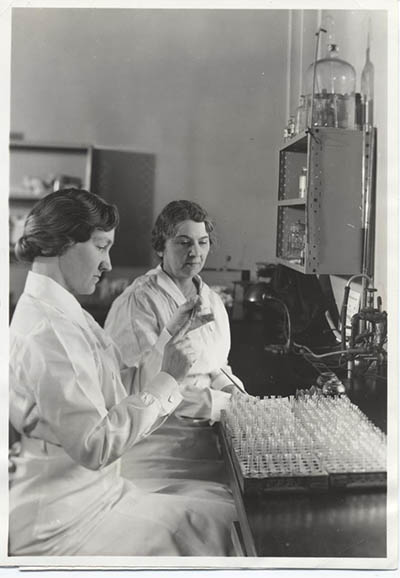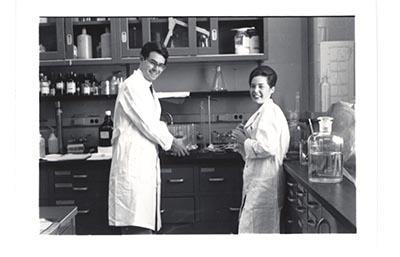From the Annals of NIH History
Biologics Regulation and Research
The People and Work of Buildings 29 and 29A

CREDIT: ROB TUCHER
Historic American Buildings Survey photograph taken of Building 29.
Two historic buildings on the NIH Bethesda, Maryland, campus will soon be demolished to make way for new structures that can accommodate modern laboratories. But never fear, the stories of the important research that went on in those buildings will be preserved on a new website hosted by the Office of NIH History and Stetten Museum.

CREDIT: NATIONAL MUSEUM OF AMERICAN HISTORY
Margaret Pittman, whose research helped generate the development of vaccines against typhoid, cholera, and pertussis, was chief of the Laboratory of Bacterial Products, on the fourth floor of Building 29. She was the first female to lead a lab at NIH. Shown: Pittman and Sadie L. Carlin reading an agglutination reaction, part of the test for potency of anti-meningitis serum. (Photo taken in 1937)
The Biologics Standards Laboratory Building (Building 29, which opened in 1960) and the Biologics Standards Laboratory Annex (Building 29A, which opened in 1967) are nationally significant to the history of medicine and public health. Within their laboratories, NIH and FDA scientists helped to conquer some of the world’s deadliest infectious diseases. In their regulatory role, the two agencies licensed vaccines, antitoxins, blood products, and other biologics to ensure their safety and effectiveness. In 2014, the FDA Center for Biologics Evaluation and Research moved from Buildings 29, 29A, and 29B (which opened in 1994) to the FDA White Oak campus in Silver Spring, Maryland. Buildings 29 and 29A have been vacant since then; Building 29B was renovated and is now occupied by NIH intramural researchers from three institutes.
After careful study, NIH determined in 2020 that Building 29 and Building 29A are functionally obsolete and that it would be cost prohibitive to rehabilitate them and impossible to resolve the physical constraints of the buildings. The Section 106 review process of the National Historic Preservation Act of 1966 requires federal agencies to identify and assess the effects its actions may have on historic buildings on their property. NIH consulted with the Maryland Historical Trust and local organizations and agreed that before the buildings were demolished, photographic surveys would be completed as well as a public website that showcased the significant science and individuals associated with the two buildings. Some of the most well-known medical and infectious-disease researchers of the 20th century worked in these buildings, as did the key administrators and others who supported their work.

CREDIT: OFFICE OF NIH HISTORY AND STETTEN MUSEUM
John Finlayson researched plasma derivatives most of his career, especially as related to hemophilia. He worked on Factor VIII, an essential blood-clotting protein, sometimes called anti-hemophilic factor (not licensed until 1966). Shown: Finlayson (left) and lab technician Mimi Reyes in 1963 in Building 29, first floor.
Although replacing Buildings 29 and 29A is a high priority for NIH, it may be several years before the buildings are demolished. NIH’s Office of Research Facilities must finish decommissioning the buildings and planning the demolition.
The Office of NIH History and Stetten Museum, the FDA History Office, and a number of others—including architects, photographers, historians, and a website programmer—teamed up to mitigate the loss of the buildings. A website—which features the stories of the people, the labs, and the work conducted in the two buildings between 1960 and 2014—is now live.

David Derenick

KATIE WATTS
David Derenick is an architect in NIH’s Division of Facilities Planning, Office of Research Facilities. He serves as the NIH Federal Preservation Officer and coordinates NIH consultation with State Historic Preservation Officers and other parties. Katie Watts is a principal investigator in history and architecture at Gray and Pape, Inc., a consulting company with headquarters in Cincinnati, Ohio, and a regional office in Richmond, Virginia, where she resides.
This page was last updated on Tuesday, May 17, 2022
